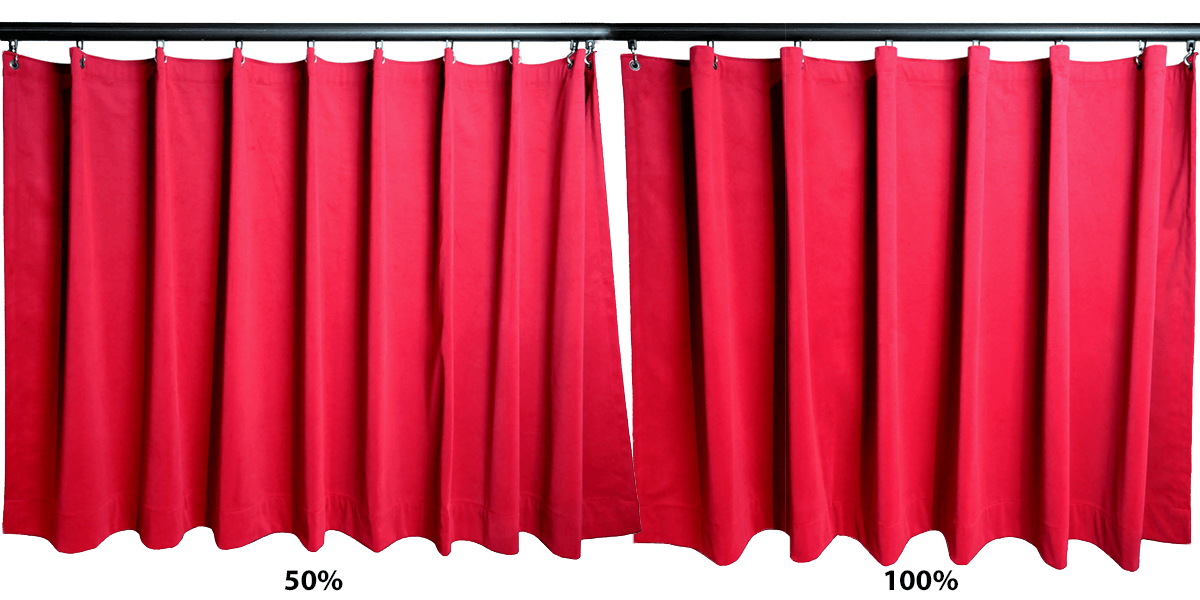About us
ShowTex is a worldwide leader in inventing, manufacturing and installing innovative flame retardant fabrics, tracks and motion control systems for achieving the creative vision of theatre, event and entertainment professionals.

Curtains can be sewn either flat or with fullness. While the visual aspect is important, opting for fullness and pleats significantly affects the functionality of the drapes as well. Therefore, take your time to select the desired amount of fullness and type of pleat that aligns best with the budget, look and style of your venue or event.
TABLE OF CONTENTS
You can hang your curtain flat or with pleats, meaning that the width of the fabric and the width of the curtain are two different things. Curtain fullness or curtain gather indicates the additional fabric that is needed to cover the total width of the opening.
A flat drape has the same width as the opening and no fullness. To achieve 50% fullness, you’ll require 1.5 times the fabric width used for a flat curtain. 100% fullness equals double that width.
For example: a drape of 10 meters wide with 100% fullness requires a fabric width of 20 meters. Through pleating, the ShowTex workshop reduces the final curtain width to 10 meters with 100% fullness.
Want to find out even more about flame-retardant fabrics, curtain openings and finishes?
Download your free copy of the ShowTex Theatre eBook
|
0% FULLNESS Required fabric width E.g. 10m wide drape |
50% FULLNESS Required fabric width E.g. 10m wide drape |
75% FULLNESS Required fabric width E.g. 10m wide drape |
|
100% FULLNESS Required fabric width E.g. 50m wide drape |
200% FULLNESS Required fabric width E.g. 50m wide drape |
Depending on how big your pleats need to be, you require more or less fullness. Usually, a curtain that is 100% full has pleats of about 15cm deep. The fuller your drape, the richer the pleats.
Pleating is quite common in fabric confection. Among other applications, pleated curtains serve as majestic prosceniums or masking drapes in theatres, add a stylish touch to event venues or allow trade show booths to stand out.
The impact of pleated curtains extends beyond the visual appearance of a room, as they also contribute to light and sound management. For example, velvet main curtains in theatres usually have 100% pleating because of the full, rich look it gives. For sheer drapes, 200% fullness can increase the opacity of the fabric, while acoustic fabrics with fullness absorb more sound.
Eventually, the desired look, use and budget will determine the amount of fullness.
There are many different curtain headings to choose from for the final look of your drapes. Check out the different pleat styles used in the ShowTex sewing workshops:
|
FLAT CURTAIN A drape with 0% fullness.
|
TIED IN FULLNESS PLEAT Requires 40% to 200% extra fabric width.
|
|
RIPPLED PLEAT Requires 10% to 800% extra fabric width.
|
SHIRRED PLEAT Requires 20% to 200% extra fabric width.
|
|
WAVE PLEAT WITH FIXED GLIDERS/RUNNERS Picture 1: gliders – Picture 3: runners Requires 50% to 300% extra fabric width.
|
|
|
EASYDRAPE PINCH PLEAT Requires 20% to 100% extra fabric width.
|
PINCH PLEAT / SINGLE PLEAT Requires 20% to 100% extra fabric width.
|
|
BUTTERFLY PLEAT / DOUBLE PLEAT Requires 100% to 200% extra fabric width.
|
TRIPLE PLEAT Requires 150% to 300% extra fabric width.
|
|
INVERTED PLEAT / REVERSE PINCH PLEAT Requires 50% to 100% extra fabric width.
|
KNIFE PLEAT Requires 50% to 200% extra fabric width.
|
|
FULL BOX PLEAT Requires 50% to 200% extra fabric width.
|
INVERTED BOX PLEAT Requires 50% to 200% extra fabric width.
|
Got a clear vision on the pleats and fullness you need? Or on the lookout for more personalised advice on your performance, venue or event decoration?